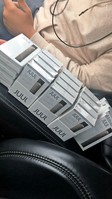Welcome to Vape’nside
Growing trend becomes an issue in Oceanside schools
Vaping is beginning to form a cloud over Oceanside schools, as more students participate in the growing trend — which nearly 1 in 3 students in 12th grade are a part of, according to a 2017 National Institutes of Health survey — and which, although it is banned in local schools, is difficult to expose.
“Vaping and all its paraphernalia are considered drug material; that’s how we interpret it,” said Oceanside school board Vice President Sandie Schoell. The activity is banned on school property, but it is difficult to catch students, as they usually vape in the bathrooms or locker rooms, where the schools lack constant monitoring.
Vaping refers to the use of e-cigarettes or similar devices. They do not produce tobacco smoke, but rather an aerosol that looks like (but is not) water vapor. Experts agree, however, that vaping is just as addicting as cigarette smoking.
The most common form of vaping in Oceanside schools is with a product made by Juul, a San Francisco-based company, according to students and officials. Since the device is small and looks like a USB thumb drive, teenagers can conceal it. Additionally, the aerosol released tends to be non-odorous and quickly fades away.
“This is a monster we’re trying to control,” Schoell, said referring to how stealthily students vape on school grounds, and how addicting it can be. The schools are looking into new technology: detectors, similar to smoke alarms, which can pick up the fumes. “If kids see other kids doing this,” she added. “And they know it’s against the rules, they need to report it.”
Students are usually caught through other students reporting them, according to Dr. Allison Glickman-Rogers, principal of Oceanside Middle School. There is no warning for first offenders either, their paraphernalia is confiscated and they are suspended from school for one to three days.
Glickman-Rogers told the Herald that she is concerned about the influence vaping companies seem to have on youth, comparing it to how tobacco companies marketed to youngsters throughout the last century. “As a school, we’re educating students on how the tobacco companies are gearing their marketing towards young people. We want our students to be critical of the marketing.”
Of the roughly 1,800 students in Oceanside High School, a few vape vape, reported an OHS senior who wished to remain anonymous — most of them use Juuls, she said, which contain liquid containers referred to as pods. She said a dozen students have already been suspended and the boys’ bathroom now has sign-in sheets.
“You get a temporary head high, it’s easily accessible, a pack of four pods from a gas station is only $20 and these pods can last like a week,” she said. “You can do it in your room, kids do it in their cars, and they look like USB flash drives. Parents can’t even tell their kids have them. If they get taken, they’re replaceable. It’s the new, updated version of smoking.”
While vaping is 95 percent less harmful than smoking, according to a 2015 Public Health England study, the liquid still contains highly addictive nicotine and other toxic substances.
“It’s an issue across the island, the state and the country,” Long Beach Aware’s Executive Director, Judy Vining, explained. She said a 2016 study by the Partnership for Drug-Free Kids found that 75 percent of e-cigarette products contain chemical additives such as benzene which are harmful to the lungs, causing conditions such as popcorn lung — where the organ’s tiny air sacs become constricted, resulting in a reduced oxygen and carbon dioxide exchange. Additionally, the metals used in the instruments such as chromium, magnesium and nickel, are heated and become dangerous when ingested.
Vining believes vaping is not a great alternative to smoking as many believe, and doing so at a young age is not wise. “We need to protect kids from vaping,” Vining said. “We need to get the information out there.”
In December 2016, the U.S. surgeon general alerted parents, educators and policymakers to discourage use of e-cigarettes, noting them a significant public health concern among youth.
Locally, there was a panel discussing the topic held by the East Rockaway Prevention Task Force in December 2017, and the Oceanside School District and Parent And School Seminar are also holding a workshop on April 17 at 7:30 p.m. at the Oceanside Middle School auditorium. The Long Island Council on Alcoholism and Drug Dependence will present.
“We have to try and educate [the children,]” Drug Advisory & Wellness Council representative and PASS co-chair Herb Pitkowsky told the Herald. “Education is the key to preventative action.”

 44.0°,
Mostly Cloudy
44.0°,
Mostly Cloudy 





